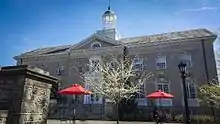Dickinson College
Dickinson College is a private liberal arts college in Carlisle, Pennsylvania. Founded in 1773 as Carlisle Grammar School, Dickinson was chartered September 9, 1783,[5] six days after the signing of the Treaty of Paris, making it the first college to be founded after the formation of the United States. Dickinson was founded by Benjamin Rush, a signer of the United States Declaration of Independence, and named "John and Mary's College" in honor of John Dickinson, a signer of the Constitution who was later the governor of Pennsylvania, and his wife Mary Norris Dickinson. They donated much of their extensive personal libraries to the new college.[6]
 | |
| Latin: Collegium Dickinsonium | |
| Motto | Latin: Pietate et doctrina tuta libertas |
|---|---|
Motto in English | Freedom is made safe through character and learning[1] |
| Type | Private |
| Established | 1773 |
| Endowment | $455.4 million (2019)[2] |
| President | Margee Ensign |
Academic staff | 272 |
| Undergraduates | 2,420[3] |
| Location | , , United States |
| Campus | Rural 170 acres (69 ha) |
| Colors | Red and White |
| Athletics | NCAA Division III – Centennial |
| Nickname | Red Devils |
| Affiliations | Oberlin Group CLAC NAICU Annapolis Group |
| Website | dickinson |
| Designated | July 1, 1947[4] |
In addition to offering either a bachelor of arts or bachelor of science degree in 22 disciplinary majors and 20 interdisciplinary majors, Dickinson offers an engineering option through its 3:2 program, which consists of three years at Dickinson and two years at an engineering school of Columbia University, Rensselaer Polytechnic Institute, or Case Western Reserve University. Upon successful completion of both portions of the program, students receive the B.S. degree from Dickinson in their chosen field and the B.S. in engineering from the engineering school.[7]
The Dickinson School of Law is located adjacent to the college campus and was founded in 1834 as its law department. It received an independent charter in 1890 and ended all affiliation with the college in 1917.[8] In 2000, the law school merged with the Pennsylvania State University.
History
18th–20th centuries
The Carlisle Grammar School was founded in 1773 as a frontier Latin school for young men in western Pennsylvania. Within years Carlisle's elite, such as James Wilson and John Montgomery, were pushing for development of the school as a college. In 1782, Benjamin Rush, a physician who was a prominent leader during and after the American Revolution, met in Philadelphia with Montgomery and William Bingham, a prominent businessman and politician. As their conversation about founding a frontier college in Carlisle took place on his porch, "Bingham's Porch" was long a rallying cry at Dickinson.
Dickinson College was chartered by the Pennsylvania legislature on September 9, 1783, six days after the signing of the Treaty of Paris (1783) that ended the American Revolution; it was the first college to be founded in the newly independent nation. Rush intended to name the college after the president of Pennsylvania John Dickinson and his wife Mary Norris Dickinson, proposing "John and Mary's College." The Dickinsons had given the new college an extensive library which they jointly owned, one of the largest libraries in the colonies.[9][10] The name Dickinson College was chosen instead. When founded, its location west of the Susquehanna River made it the westernmost college in the United States. For the first meeting of the trustees, held in April 1784, Rush made his first journey to Carlisle. The trustees selected Charles Nisbet, a Scottish minister and scholar, to serve as the College's first president. He arrived and began to serve on July 4, 1785, serving until his unexpected death in 1804.[11]
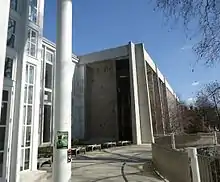
A combination of financial troubles and faculty dissension led to a college closing from 1816 to 1821. In 1832, when the trustees were unable to resolve a faculty curriculum dispute, they ordered Dickinson's temporary closure a second time.[12]
The law school dates to 1833. It became a separate school 1890, although the law school and the college continued to share a president until 1912. The law school is now affiliated with the Pennsylvania State University.[12]
Among the 18th-century graduates of Dickinson were Robert Cooper Grier and Roger Brooke Taney, who later became U.S. Supreme Court justices, and served together on the court for 18 years.
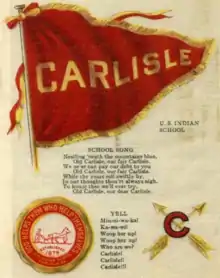
During the 19th century, two noted Dickinson College alumni had prominent roles in the lead up to the Civil War. They were James Buchanan, the 15th president of the United States, and Roger Brooke Taney, the 5th chief justice of the United States. Dickinson is one of three liberal arts colleges to have graduated a president and a chief justice (Bowdoin and Amherst are the others). Taney led the Supreme Court in its ruling on the Dred Scott v. Sandford decision, which held that Congress could not prohibit slavery in federal territories, overturning the Missouri Compromise. Buchanan threw the full prestige of his administration behind congressional approval of the Lecompton Constitution in Kansas. During the Civil War, the campus and town of Carlisle were occupied twice by Confederate forces in 1863.[13]
When George Metzger, class of 1798, died in 1879, he left his land and $25,000 (equivalent to $686,000 in 2019) to the town of Carlisle to found a college for women. In 1881, the Metzger Institute opened. The college operated independently until 1913, when its building was leased to Dickinson College for the education of women. The building served as a women's dorm until 1963.[14]
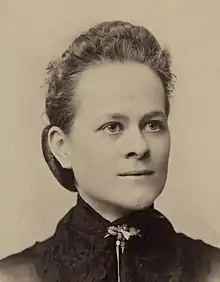
In 1887, Zatae Longsdorff became the first woman to graduate from Dickinson.[15][16] In 1901, John Robert Paul Brock became the first black man to graduate from Dickinson; in 1919, Esther Popel Shaw was the first black woman to graduate.[17]
Henry Clarke, an alumnus who developed the Klondike bar into a national brand for an ice cream bar, founded the Clarke Forum for Contemporary Issues at Dickinson College, and in 1994 established the Clarke Center.[18]
The town of Carlisle was also the location of the Carlisle Army Barracks, which was adapted in the late 1870s for use as the Carlisle Indian Industrial School. In 1879 Dickinson College and the nearby Carlisle Indian School began a collaboration, when James Andrew McCauley, president of the college, led the first worship service at the Indian School. The collaboration between the institutions lasted almost four decades, from the opening day to the closing of the Indian School in 1918. Dickinson College professors served as chaplains and special faculty to the Native American students.[19] Dickinson College students volunteered services, observed teaching methods, and participated in events at the Indian School.[20] Dickinson College accepted select Indian School students to attend its Preparatory School ("Conway Hall") and gain college-level education.[21]
Dickinson also admitted Native American students directly: Thomas Marshall was one of the first such students at Dickinson. In 1910, Frank Mount Pleasant was the first Native American to graduate from Dickinson College.
21st century
Since 2000, Dickinson's acceptance rate has dropped by 20%, SAT scores have risen by 100 points, and the institutional endowment has more than doubled.[22]
In 2000 Dickinson opened a new science building, Tome Hall, a state-of-the-art interdisciplinary facility to host astronomy, computer science, math, and physics. Tome houses Dickinson's innovative "Workshop Physics" program and was the first stage of a new science complex.[23] Opened in 2008, the LEED Gold certified Rector Science Complex serves as a place of scientific exploration and learning in an environment that is artful and sustainable. Featuring 90,000 square feet (8,400 m2) of laboratories, classrooms and research facilities, it houses the departments of biology, chemistry, psychology and interdisciplinary programs in biochemistry & molecular biology and neuroscience. Courses in the emerging fields of bioinformatics and nanotechnology are also taught there.
On January 22, 2013, Dickinson announced that it had acquired Allison United Methodist Church for college expansion. A longtime landmark in Carlisle, Allison's limestone building and property is contiguous with the Benjamin Rush campus of Dickinson. The building, located at 99 Mooreland Avenue, provides the college with more than 33,000 square feet (3,100 m2) for events, guest speakers, student presentations, meetings, ecumenical worship and additional offices.[24]
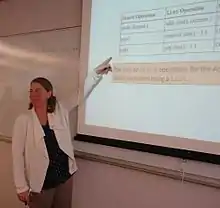
Dickinson aims for campus environmental sustainability through several initiative. In the Sustainable Endowments Institute's 2010 green report card Dickinson was one of only 15 schools in the USA to receive an A-, the highest grade possible. In the same year, Dickinson was named a Sierra magazine "Cool" School" in its Comprehensive Guide to the Most Eco-Enlightened U.S. Colleges: Live (Green) and Learn.[25] The college's commitment to making study of the environment and sustainability a defining characteristic of a Dickinson education was also recognised through being top of The Princeton Review's 2010 Green Honor Roll.[26]
In 2008, the college bought 100% of its energy from wind power,[27] had solar panels on campus,[28] owned and operated an organic garden and farm,[29] and had signed the American Colleges & Universities Presidents Climate Commitment.[30] The college's emphasis on sustainability education recognizes its importance for innovation and the lives of tomorrow's graduates.[31][32][33] The college had made a commitment to being carbon neutral by 2020.[34] This involved a mixture of increased energy efficiency on campus, switching energy sourcing, promoting behavior change and carbon ofsetting.[35]
Campus
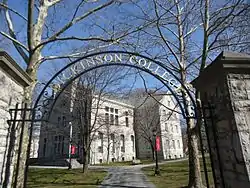
Dickinson's quiet campus is three blocks from the main square in the historic small town of Carlisle, the county seat of Cumberland County, Pennsylvania, and the site of the nation's second oldest military base, Carlisle Barracks, which is now used as the U.S. Army War College. The campus is characterized by limestone-clad buildings and has numerous trees.

The frontier grammar school was founded in 1773 and housed in a small, two-room brick building on Liberty Avenue, near Bedford and Pomfret streets. When Dickinson College was founded in 1783, this building was expanded to accommodate all the functions.[36] In 1799 the Penn family sold 7 acres (2.8 ha) on the western edge of Carlisle to the nascent college, which became its campus. On June 20 of that year, the cornerstone was laid by founding trustee John Montgomery for a building on the new land.[37] The twelve-room building burned to the ground on February 3, 1803, five weeks after opening its doors. The college operations were temporarily returned to its previous accommodations.
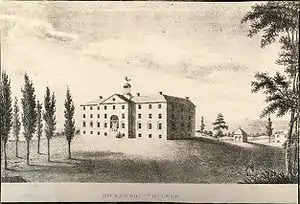
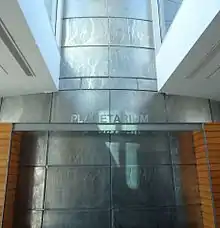
Within weeks of the fire, a national fundraising campaign was launched, enticing donations from President Thomas Jefferson, Secretary of State James Madison, Chief Justice John Marshall, and many others. Benjamin Latrobe, already noted for his design work on the Bank of Pennsylvania and Princeton University's Nassau Hall, and soon-to-be named as Architect of the Capitol, was chosen to design the new structure. Latrobe's design for the building, now known as "West College" or "Old West," featured monumental and classical elements within a simple and subdued academic style. The building was to be capped with a classically inspired cupola graced by a figure of Triton. The local craftsman instead created a mermaid, which has since been a symbol of the college. Latrobe, who donated his services to the college, visited the building for the first time in 1813. The total cost of West College topped $22,000 and, although classes began in 1805, work was not finished until 1822. More than 200 years after its doors opened for the first time, Old West is today the ceremonial heart of the college, as all students march through the open doors during convocation at the beginning of their freshman year, and march out the same doors to receive their degrees and graduate. Old West, which is listed on the National Register of Historic Places, also houses the college administration, several classrooms, a computer lab, and the college chapel.
Throughout the 19th century Dickinson expanded across what has now become its main academic quadrangle, known formally as the John Dickinson Campus. Dickinson expanded across College Street to build the Holland Union Building and Waidner-Spahr Library, which along with several dormitories, makes up the Benjamin Rush Campus. Across High Street (U.S. Route 11) lies the Charles Nisbet Campus, home to the largest grouping of dormitories. The Dickinson School of Law, part of Penn State, lies directly to the south of the Nisbet Campus. Together these three grass-covered units compose the vast majority of the College's campus, though several outlying buildings surround these main areas. In addition, the College owns playing fields and a large organic farm, both of which are only a short distance from the main campus.
Buildings of note include:
- Althouse Hall[38] - A science hall opened in 1958, Althouse housed the chemistry department until it moved to the new Rector Science Complex. Since the spring 2010 semester, this building houses the International Business & Management Program as well as the Economics department.
- Bosler Hall[39] - Completed in 1886, the building was Dickinson's first purpose-built library. Today it houses foreign language classes.
- East College[40] - Dickinson's second building, which at one time housed the college president and served as a dormitory and place of instruction. East College also served as Confederate hospital during the Battle of Carlisle in July 1863. Today East College houses the departments of religion, classical studies, English, and other humanities.

- Denny Hall[41] - completed in 1896 but destroyed by fire in 1904, the current building dates to 1905 and was given in memory of Harmar Denny and his family, several of whom are Dickinson alumni. Denny currently houses the departments of political science, history, anthropology, and archeology, amongst others.
- Holland Union Building (HUB)[42] - Opened in 1964, the HUB is Dickinson's expansive student union, and hosts the cafeteria, snack bar, an organic cafe, student offices and services, and the bookstore.
- Kline Athletic Center[43] - Finished in 1979, the Kline Center is a multipurpose facility that houses many of the varsity and intramural sports that Dickinson offers. In addition, the building features a modern fitness center, pool, indoor track, basketball, squash, and racquetball courts, and a climbing wall.
- Rector Science Complex[44] - Opened in 2008, the new science complex, crowned by Stuart and James halls, joined with Tome Hall to create a completely unified interdisciplinary science campus that houses the departments of biology, chemistry, psychology and interdisciplinary programs in biochemistry, molecular biology and neuroscience. This building was constructed on the site of James Hall, which formerly housed geology, psychology, and environmental science and was demolished in 2006.
- Stern Center for Global Education[45] - Finished in 1885 as the Tome Scientific Hall, it was one of the nation's first science-only academic buildings. In 2000, a new science building was completed, itself taking the name Tome Hall. The Stern Center houses the college's global education programs and segments of the international studies, international business and management, and East Asian studies majors.
- Tome Hall[46] - Opened in the year 2000, Tome is the home to physics, astronomy, math, and computer science.
- Waidner-Spahr Library[47] - Opened as the Spahr Library in 1967, the building was a modern home for Dickinson's rapidly expanding collection. In 1997 the building was reopened as the Waidner-Spahr Library, after a massive expansion and renovation project. It houses the library's collection of over 510,000 volumes and 1,600 periodicals, as well as student study space and computer labs.[48]

Student life
Dickinson has a rich and varied student life with a variety of organizations involved in many different causes and interests. Its programs are geared only toward traditional students of typical college age. There are over a hundred organizations representing different facets of the college.[51]
Theatre and performing arts
Working in cooperation with the Dickinson Department of Theatre and Dance, The Mermaid Players, Dickinson's student-run theatrical society, offers Dickinsonians the opportunity to experience live theatre in a variety of ways. Performances normally occur in Mathers Theater, located in the HUB, or The Cubiculo (aka the Cube), a black-box space located above the Carlisle Theater. However their collective creativity does not limit them to 'traditional' spaces, as recent performances have seen the audience seated on the Mathers stage, or at the Dickinson Farm for an outdoor performance of 'The Grapes of Wrath'.
Athletics

The Dickinson Red Devils participate in the NCAA Division III Centennial Conference.[52] The Red Devils sport uniforms of red, white, and black.
Dickinson has 23 varsity sports teams, including baseball and softball, men's and women's golf, men's and women's soccer, football, men's and women's tennis, men's and women's track, men's and women's basketball, men's and women's lacrosse, men's and women's swimming, men's and women's cross country, men's and women's riding, women's volleyball, and women's field hockey. The college also has a cheerleading squad and dozens of intramural and club sports including ice hockey, men's volleyball, lacrosse, soccer, and ultimate frisbee.
The school's cross country teams are led by long standing coach Don Nichter. The women's cross country team has made 15 consecutive appearances at the Division III National Championships.[53] The men's team has seen similar success, with eight consecutive appearances at the nationals championships.[54]
The current football coach at Dickinson is Brad Fordyce.
Dickinson won a notable football victory in 1931, defeating Penn State 10-6 under head coach Joseph McCormick.[55] The two teams have not met since.[56]
Dickinson won the 1958 men's lacrosse team national title and Roy Taylor Division championship, also defeating Penn State in its final game to clinch the title.
Dickinson lacrosse continues today under men's lacrosse coach Dave Webster '88 whose squad posted a compiled record of 65-10 over the 2010, 2011, 2012 and 2013 seasons. The team won three consecutive Centennial Conference Championships (2011, 2012, 2013) and went to the NCAA tournament four consecutive years (2010, 2011, 2012, 2013). Prior to the 2010 season, Dickinson had never been in the NCAA tournament. In 2013, Heather Morrison '15 and Brandon Palladino '13 were named the NCAA Division III Outstanding Players of the Year: Iroquois Nationals Award. Palladino was also the first player in Centennial Conference history to earn first-team all-conference honors all four years of his career.
Dickinson's men's basketball team won Centennial Conference titles in 2013 and 2015, and an at-Large bid to the NCAA tournament in 2014. Dickinson reached the "Elite Eight" in the 2014 D-III tournament.[57] Gerry Wixted '15 was named D-III National Player of the Year in 2015.[58]
In May 2019, the Dickinson College Softball Team won the Centennial Conference Championship. Madison Milaszewski earned the 2019 Centennial Conference MVP Award.
From 1963 to 1994, the college hosted the summer training camp for the NFL's Washington Redskins.[59][60]
Music
Approximately 300 students study music at Dickinson every year. All music courses, performance studies and ensembles are open to all Dickinson students regardless of major.
Music ensembles, which are open to all students by audition, include the Dickinson College Choir, the Dickinson College Collegium, the Dickinson College Jazz Ensemble, the Dickinson Orchestra, the Dickinson Improvisation and Collaboration Ensemble, and the Dickinson Chamber Ensembles. There is a vibrant music scene of student-led groups, which is supported by Dickinson by way of "The Band Aid," a college-sponsored practice space for student-led bands that is available to all students.[61] The "Treehouse" dormatory sponsors frequent student-led group and individual performances, including open mike nights.
The Music House, a music-themed special interest housing option, and the Dickinson College Student Music Society sponsor many activities throughout the year, including music field trips to metropolitan areas such as New York City and Washington, D.C., an annual children's concert, and music outreach programs to local schools.
Language, culture, and global education
Dickinson College has various on-campus houses and clubs dedicated to language and culture. On-campus student houses include a Romance Language House,[62] the Russian House,[63] the Global Community House,[64] and the Social Justice House.The Center for Sustainable Living, or Treehouse, is an on-campus student house dedicated to sustainability and environmentalism.[65]
Each year, some Dickinson students have the opportunity to spend one year abroad pursuing accredited study, at such institutions as the University of Oxford throughout the world.
Religious life
Dickinson has a number of different religious organizations, including the Harlow Family Hillel and the Asbell Center for Jewish Life,[66] the Dickinson Christian Fellowship (DCF), the Dickinson Catholic Campus Ministry (DCCM), DiscipleMakers Christian Fellowship, and the Muslim Educational and Cultural Association (MECA).
Academic honor societies
National organizations recognizing academic achievement include Alpha Lambda Delta[67] and Phi Beta Kappa. Dickinson's Phi Beta Kappa chapter, the Alpha of Pennsylvania, is the first established in the state.
Greek organizations
Dickinson College has three recognized fraternities: Delta Sigma Phi, Kappa Alpha Psi, and Sigma Lambda Beta. The college has five recognized sororities: Delta Nu, which was founded at Dickinson College in 1971; Kappa Alpha Theta, Kappa Kappa Gamma, Pi Beta Phi, and Sigma Lambda Gamma.[68] Fraternities that are suspended, inactive, or not currently recognized by the school include: Kappa Sigma and Phi Delta Theta, both unrecognized by the school in 2017; Phi Kappa Sigma (Epsilon chapter), established in 1854 as the first fraternity at Dickinson until it was suspended in 2009;[69][70] Sigma Alpha Epsilon, suspended in 2012;[71][72] Theta Chi, unrecognized by school in 2008;[73] Beta Theta Pi, which founded its Alpha Sigma chapter at Dickinson in 1874 and was suspended in 2000; and Sigma Chi, unrecognized by school in 2004.[74]
The Dickinsonian
The Dickinsonian is an award-winning student-run newspaper published by students, first published in 1872.
School songs
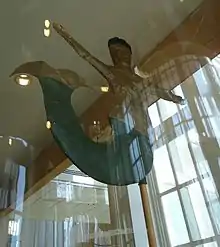
The college's musical tradition dates back to at least 1858 when the Medal of Honor recipient and author, alumnus Horatio Collins King, wrote the alma mater, "Noble Dickinsonia" to the tune of "O Tannenbaum" ("O Christmas Tree"). In 1937 the College published a book titled Songs of Dickinson, which contains over 70 works from Dickinson's past. In 1953 the men's glee club recorded an album of college songs. In 2005-2006, The Octals, Dickinson's all-male a cappella group, recorded a similar CD.
Hat Societies
Dickinson College has four "Hat Societies" on its campus. This name is given by the distinctive hats members wear on campus. To gain admittance into a hat society, one is "tapped" as a junior by current senior members to then serve as a member during his or her senior year. The induction ceremony is known as a tapping ceremony. While membership criteria differ amongst the organizations, overall character and general campus leadership are major requirements for membership in any of the organizations.[75]
The four hat societies at Dickinson College are:[76]
- Raven's Claw or "White Hats" - 7 senior men (est. 1896)
- The Order of Scroll and Key or "Gray Hats" - 7 senior men[77] (est. 2001)
- Wheel and Chain or "Blue Hats" - 10 senior women (est. 1924)
- Queer Caps (est. 2008)
Alumni
Notable alumni of Dickinson College include Chief Justice of the United States Roger B. Taney (1795); President of the United States James Buchanan (1809); John Goucher (1868), the founder of Goucher College; Baseball Hall of Fame pitcher Chief Bender (1902); former chief of the Strategic Air Command of the United States Air Force (SAC) Richard H. Ellis (1941); and baseball executive Andy MacPhail (1976), Inspector General for the U.S. Agency for International Development Ann Calvaresi Barr (1982).
Rankings and awards
| University rankings | |
|---|---|
| National | |
| Forbes[78] | 118 |
| THE/WSJ[79] | 100 |
| Liberal arts colleges | |
| U.S. News & World Report[80] | 46 |
| Washington Monthly[81] | 49 |
- In 2010, Dickinson was one of only 15 schools to receive an A- in the Sustainable Endowments Institute's 2010 green report card.
- In 2010, the college was named a Sierra magazine "Cool School" in its Comprehensive Guide to the Most Eco-Enlightened U.S. Colleges.[25]
- In 2010, the college's commitment to making study of the environment and sustainability a defining characteristic of a Dickinson education landed it at the top of The Princeton Review's 2010 Green Honor Roll.[26]
- In 2006, the college was ranked the most physically fit school in America by Men's Fitness.[82]
- In 2006, Dickinson decided to stop publicizing its ranking in "America's Best Colleges" from U.S. News & World Report; however, in 2015 rankings Dickinson placed #40 among National Liberal Arts Colleges. In May 2007, Dickinson President William G. Durden joined with other college presidents in asking schools not to participate in the reputation portion of the magazine's survey.[83][84]
- The Institute of International Education (IIE) ranked Dickinson No. 5 for yearlong study abroad and No. 11 for semesterlong study abroad in the baccalaureate category of its most recent Open Doors report (for the 2013-14 academic year).[85]
- Dickinson is a perennial producer of Fulbright Scholars, and the Department of State’s Bureau of Educational and Cultural Affairs has named Dickinson a Top Producer every year for the last six years.[86] It is also a top producer of Peace Corps Volunteers, ranking 8th among small colleges and universities in 2014.[87]
References
- "The College Seal". Dickinson College. n.d. Retrieved August 28, 2015.
- As of June 30, 2019. "U.S. and Canadian Institutions Listed by Fiscal Year (FY) 2019 Endowment Market Value and Change in Endowment Market Value from FY 2018 to FY 2019". National Association of College and University Business Officers and TIAA. Retrieved February 28, 2020.
- Paul, Korey. "Enrollment Data". Dickinson College. Retrieved December 7, 2016.
- "PHMC Historical Markers Search" (Searchable database). Pennsylvania Historical and Museum Commission. Commonwealth of Pennsylvania. Retrieved January 25, 2014.
- "Dickinson Facts". Dickinson College. Archived from the original on April 5, 2007.
- Butterfield, L.H. (1948). "Benjamin Rush and the Beginning of John and Mary's College Over the Susquehanna". Journal of the History of Medicine and Allied Sciences. Oxford Journals. III (3): 427–442. doi:10.1093/jhmas/III.3.427.
- "Engineering option". Dickinson College. Retrieved September 19, 2014.
- "The Dickinson Story". The Dickinson Story. Dickinson College.
- "The Books of Isaac Norris at Dickinson College". Dickinson College. The Dickinson Electronic Initiative in the Liberal Arts. Retrieved February 11, 2013.
- McKenney, Janice E. (November 15, 2012). Women of the Constitution: Wives of the Signers. ISBN 978-0810884984.
- "Charles Nisbet, First President of Dickinson College". Dickinson College. Archived from the original on December 30, 2007.
- "The Dickinson Story". Dickinson College.
- "1851-1900 Timeline". Chronicles. Dickinson College. Retrieved October 8, 2009.
- "Metzger Hall". Chronicles. Dickinson College. Archived from the original on April 9, 2009. Retrieved October 8, 2009.
- "Zatae Longsdorff Straw (1866-1955)". Archives & Special Collections. Dickinson College. Retrieved September 2, 2019.
- Cress, Joseph (March 28, 2015). "Women's History Month: Zatae Longsdorff was considered a pioneer among Dickinson College graduates". The Sentinel.
- "Red Devil of the Week: Elaine Vivian Watson Class of 1984". The Dickinsonian. February 14, 2019. Retrieved September 1, 2019.
- Hall, Christine (April 8, 2013). "Henry Clarke, 79, Made Klondike Bar Famous, Former Greenwich Resident". Greenwich Daily Voice. Retrieved April 30, 2013.
- Professor Charles Francis Himes, Dr. George Edward Reed, Stephen Baird, and Joshua Lippincott fostered the relationship between the institutions through religious services, advisory meetings, lectures, and commencement speeches. http://wiki.dickinson.edu/index.php?title=Influence_from_the_Faculty_at_Dickinson&action=edit
- Dickinson students visited the Indian School to offer their talents and services. The October 24, 1896 Dickinsonian reported that volunteer Sunday School teachers came from the college chapter of the YMCA. Those teachers with Indian students were said to "enjoy a rare privilege. The work is doubly interesting because one can be studying the characteristics of his scholars, at the same time learning many valuable lessons in methods of teaching." The college gave Dickinson students a half-day holiday to attend the annual commencement and "very interesting exercises" at the Indian School.
- "History of Conway Hall". Dickinson College Wiki. Retrieved September 19, 2014.
- "Institutional Research". Dickinson College. Archived from the original on December 2, 2007.
- "Workshop Physics Homepage". Dickinson College. Archived from the original on October 19, 2002. Retrieved September 19, 2014.
- "Allison Church Announcement". Dickinson College. Retrieved September 19, 2014.
- Sierra Magazine. "Cool Schools: Top 100 Schools- September/October 2010". Sierra Club. Archived from the original on October 5, 2011. Retrieved December 2, 2012.
- "Dickinson Lands on the Green Honor Roll". Dickinson College. Archived from the original on January 4, 2013.
- "Dickinson College - Sustainability". Dickinson College. Archived from the original on January 13, 2008.
- "Trash on the Plaza". Dickinson College. March 23, 2007. Archived from the original on December 13, 2007.
- "News and Events - Dickinson Farm". Dickinson College. September 2007. Archived from the original on January 16, 2008.
- "College Presidents Pledge to Cut Greenhouse-Gas Emissions". Dickinson College. June 12, 2007. Archived from the original on November 2, 2007.
- Ram Nidumolu; C.K. Prahalad; M.R. Rangaswami. (September 2009). "Why Sustainability Is Now the Key Driver of Innovation". Harvard Business Review. Retrieved September 19, 2014.
- David A. Lubin; Daniel C. Esty. (May 2010). "The Sustainability Imperative". Harvard Business Review. Retrieved September 19, 2014.
- Wendy Stubbs; Chris Cocklin. "Teaching sustainability to business students: shifting mindsets". International Journal of Sustainability in Higher Education, Vol. 9 Iss: 3, pp.206 – 221 (2008). Retrieved September 19, 2014.
- "12,000 Solar Panels to Provide 30 Percent of Campus Electricity Needs". Dickinson College. August 7, 2018.
- "Climate Action: Carbon neutral in 2020". Dickinson College. Retrieved February 29, 2020.
- Reeves, Robert. "The Old College Lot". Dickinson College. Retrieved December 7, 2016.
- "Morgan's History - College Sites and Early Buildings". Dickinson College. Retrieved December 7, 2016.
- "Althouse Science Hall". Dickinson College. Archived from the original on September 12, 2007.
- "Bosler Hall". Dickinson College. Archived from the original on January 16, 2008.
- "East College". Dickinson College. Archived from the original on January 16, 2008.
- "Denny Memorial Hall (1905)". Dickinson College. Archived from the original on November 18, 2007.
- "Holland Union Building". Dickinson College. Archived from the original on November 16, 2007.
- "The Kline Center". Dickinson College. Archived from the original on December 10, 2007.
- "Dickinson College - New Science Complex". Dickinson College. Archived from the original on January 3, 2008.
- "Tome Scientific Building". Dickinson College. Archived from the original on November 18, 2007.
- "New Science Building (NSB)". Dickinson College. Archived from the original on November 16, 2007.
- "Waidner-Spahr Library". Dickinson College. Archived from the original on December 2, 2007.
- "Waidner-Spahr Library". Dickinson College. Retrieved December 7, 2016.
- "Emil R. Weiss Center for the Arts". Dickinson College. Archived from the original on December 10, 2007.
- "The Trout Gallery". Dickinson College. Retrieved December 7, 2016.
- "Dickinson College - For Students". Dickinson College. Archived from the original on August 27, 2007.
- "NCAA Division III Conferences and Independents for 2007". afca.com.
- "Red Devils Finish 11th at Nationals!". dickinsonathletics.com. November 21, 2015.
- "Weinhoffer, Stender Run to All-America Honors". dickinsonathletics.com. November 22, 2014.
- "College Football Data Warehouse". cfbdatawarehouse.com. Retrieved September 19, 2014.
- Gobrecht, Wilbur J. (1971). The History of Football at Dickinson College, 1885-1969. Chambersburg, PA: Kerr Printing Co. p. 199.
- "2014 D3hoops.com Men's Basketball Bracket". D3hoops.com. Retrieved February 15, 2020.
- "2015 D3hoops.com men's All-America team - D3hoops". D3hoops.com. Retrieved December 7, 2016.
- Maraniss, David. "Coach, Symbol, Savior". ESPN. Retrieved September 19, 2014.
- "The Carlisle Blitz: Redskins Fans Ready to Bump and Run". The Washington Post. Retrieved September 19, 2014.
- "Jam Space - The Idea Fund". dickinson.edu. Retrieved December 7, 2016.
- "Romance Language House". www.dickinson.edu.
- "Russian". www.dickinson.edu.
- "Global Community House". www.dickinson.edu.
- "Treehouse". www.dickinson.edu.
- "Asbell Center for Jewish Life". www.dickinson.edu.
- "Academic Honorary Societies, Class Councils and Club Sports". dickinson.edu. Archived from the original on September 3, 2014. Retrieved August 27, 2014.
- "Fraternities and Sororities". dickinson.edu. Archived from the original on September 3, 2014. Retrieved August 27, 2014.
- "Dickinson College Interfratenity Council: Phi Kappa Sigma". www2.dickinson.edu.
- "Welcome to the Epsilon Chapter of Phi Kappa Sigma". www2.dickinson.edu.
- "Sigma Alpha Epsilon - Pennsylvania Sigma-Phi Chapter". www2.dickinson.edu.
- "SAE" (PDF). Dickinson.edu.
- "Theta Chi". ThetaChi.org. Archived from the original on September 3, 2014. Retrieved August 27, 2014.
- Farr, Leah. "Ex-Frat Sues Dickinson". The Sentinel. Retrieved August 27, 2014.
- "Dickinson College Division of Student Life". Dickinson College. Retrieved February 28, 2011.
- Atluri, Sai (October 2, 2020). "College Taps Newest Secret Society Classes".
- "The Order of Scroll and Key: About". dickinson.edu. Retrieved December 7, 2016.
- "America's Top Colleges 2019". Forbes. Retrieved August 15, 2019.
- "Wall Street Journal/Times Higher Education College Rankings 2021". Wall Street Journal/Times Higher Education. Retrieved October 20, 2020.
- "Best Colleges 2021: National Liberal Arts Colleges". U.S. News & World Report. Retrieved September 24, 2020.
- "2020 Liberal Arts Rankings". Washington Monthly. Retrieved August 31, 2020.
- Millado, Nate (2006). "Fittest Colleges in America 2006". Men's Fitness. Men's Fitness. Archived from the original on February 20, 2010.
- It's time to move past rankings: Colleges opt out of U.S. News survey, The Patriot-News, June 10, 2007, archived from the original on January 3, 2008, retrieved March 11, 2008
- "Liberal Arts College Presidents Speak Out on College Rankings". CollegeNews. August 2004. Archived from the original on April 19, 2014. Retrieved April 18, 2014.
- "2013-14 - Leading Institutions: Duration/Inst. Type - U.S. Study Abroad - Open Doors Data". iie.org. Retrieved December 7, 2016.
- "Dickinson Again Recognized for Fulbright Program Success". dickinson.edu.
- "Peace Corps Top Colleges 2014" (PDF). Peace Corps. Retrieved September 2, 2019.
